Neil Peart's News, Weather and Sports
Angels Landing
NeilPeart.net, November 8, 2013
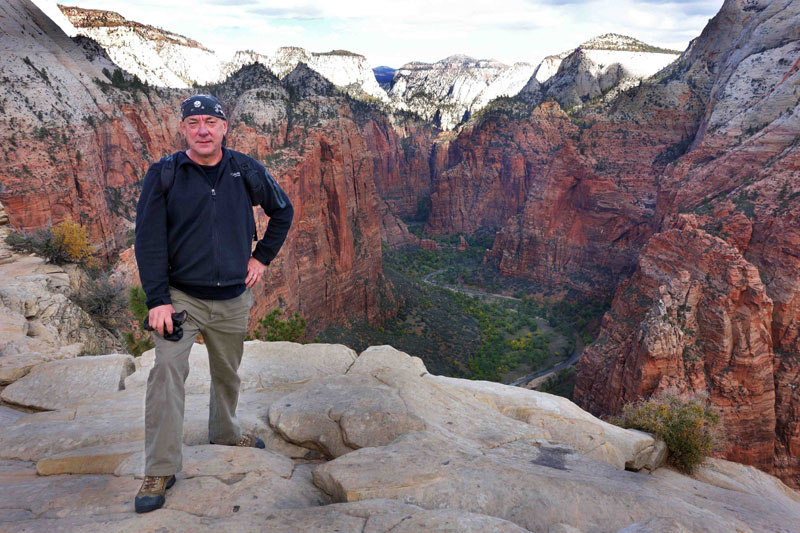 |
Zion National Park, Utah |
To open on a positive note - or positive chord, more like, G Major perhaps - this is a portrait of a happy man. And we do not use the word "happy" lightly. The attainment of where he is standing (Angels Landing) will be recounted soon, but the back story is important, too. The rock combo he had played in for thirty-nine years was on "indefinite hiatus," and his bandmates (the Guys at Work) had agreed not to even talk about work for at least a year.
(Just after the band's tour ended, he was enjoying one of the pleasures of being home, the Sunday crossword, and saw this clue: "Rush job?" The answer was "rockconcert," which made him smile - nice tribute!- but also think, "Not for a while!")
So for the first time in over a year, he wasn't counting down the days until his next departure. For the first time in ten years, he was free of work obligations and schedules, and for these few days, he was even free of family commitments. Some months ago his wife Carrie announced that she was planning a trip to Chicago and New York City with her mother and their daughter to visit friends of hers, and asked him to join them. When he thought about airports, luggage, hotels, and big cities, he said, "You know what? I've had enough of all that for a while. You girls go and have a good time. I'll stay home - maybe go on a roadtrip for a few days."
Now I was on the second day of a five-day journey through Southwestern Utah in my new Aston Martin Vanquish. (Ordered the previous year, and delivered during a break in the tour, I had only been able to put a few hundred miles on it.) I paused to spend a day hiking in both Zion and Bryce Canyon National Parks, and altogether would drive over 1,500 miles, and hike about fifteen - enjoying both to their fullest.
The photo credit refers to a passing hiker at Angels Landing who courteously took my outstretched camera and snapped the shot. While snacking on an apple and some cheese and enjoying the hard-won view, I had heard him speaking German with his two hiking companions. Other people around us spoke French, or had British accents, among the many European and Asian visitors I encountered. They must have been as grateful as I was that the State of Utah had undertaken to reopen its national parks, despite the shameful government "shutdown." I had been planning my visit for a month, and had a backup plan if the national parks remained closed. But what did these foreigners think of a country in which a few mean-spirited creeps could hold the entire country hostage - all for the principle of denying mercy to the suffering (because it might be "their own fault" - hardly a Christian objection), while also denying its citizens (and "resident aliens," as this Canadian is classified) access to their property? (A flashing sign inside Bryce Canyon National Park put it nicely: "Welcome to Bryce. Enjoy Your Park.")
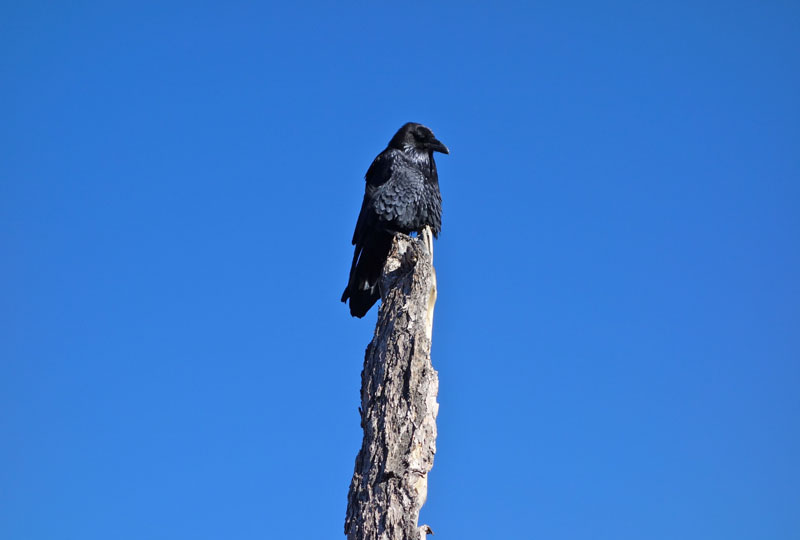 |
Quoth the raven, "Nevermore" |
These foreign visitors, like the American seniors who also visit the national parks outside the summer months, might have waited all their lives for this one opportunity. And there are tens of thousands of Americans, especially in the West, whose livelihoods are tied to the national parks. (One county in Utah, San Juan, claims seventy percent of its residents depend on the parks for their family income.) As one Utah official said, "It's not like we can miss October and make it up in January."
For this reporter, the politics are one thing - but now it was personal. Compacting what could easily become a rant into a brief blast, clearly those few miserable, damaged egos (I almost said "souls," but no) in Congress didn't care about any damn foreigners - or their own people. Like renegade bikers and surly rednecks, they ought to wear DILLIGAF T-shirts. Their message is the same, "Do I Look Like I Give a Fornication?"
(The world would be a far better place if their parents hadn't!)
That is an expression of pure evil, and those who profess it might as well be vaporized on sight. Apparently about one in every hundred humans is a sociopath - a scary thought. And just such grandiose, cynical, and merciless semi-humans are the ones who would seek power and abuse it.
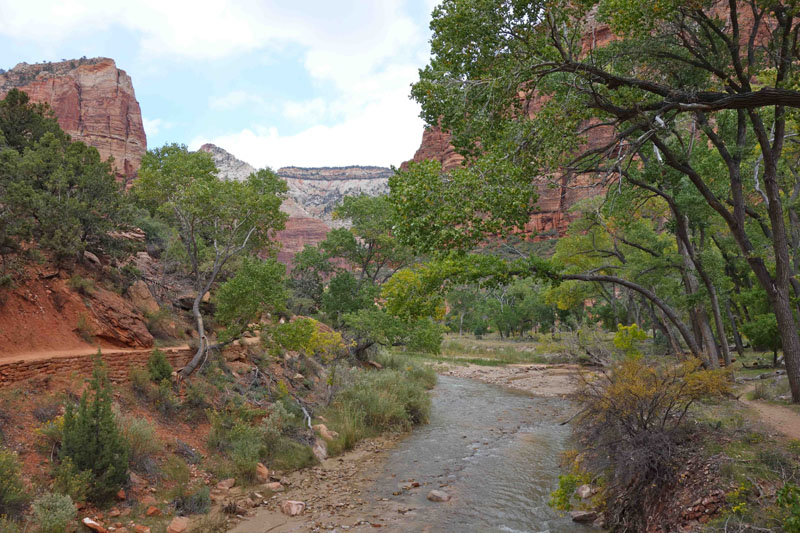 |
Virgin River, Zion |
One way to fight back is to set a better example. During my recent downtime, while I enjoyed spending time at my desk writing stories, I had quietly pledged to try to do something for someone else every day. A former belief in karma got hammered out of me about sixteen years ago, but as I have written since, "Any undamaged individual knows how good it can feel to help others." In this case, nothing big, but a host of small favors. Letters to neglected friends who will appreciate the thought, thank-you notes to strangers for gifts I received on the road, an introduction to brother Danny's book of poetry, or friend Gavin Harrison's book of drum transcriptions, auditioning niece Hannah's "indie acoustic" music and trying to give her some worthwhile encouragement - interactivities like that which demanded time and attention to do properly, and willingly. Because my T-shirt, and my heart, say, "IGAF."
The date of my climb to Angels Landing was October 15, 2013, exactly fifteen years less a day since my one previous visit to the national parks of Southwestern Utah, on my Ghost Rider travels. As part of my planning this time, I reread those passages in the book, especially the letters to Brutus and Mendelson Joe from Zion and Bryce Canyon. I had not looked at those pages for many years, ever more unwilling to relive those times, so I was hesitant. Not long ago the book's publisher asked me to record the audiobook, and I said no - I knew it would be an awful task for me. Even auditioning other potential narrators was tough, and a few paragraphs of each were all I could take. I just picked one that seemed good, and gave the project my blessing.
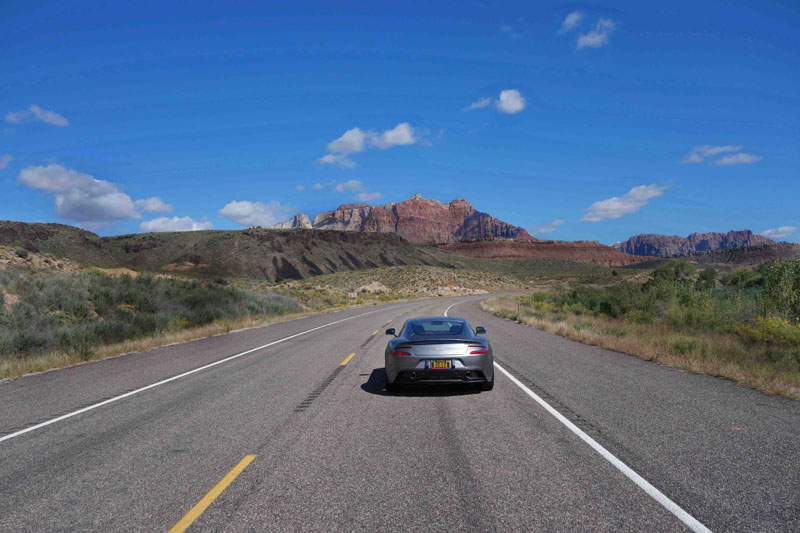 |
Approaching Zion |
The scars remain tender. Never, ever healed, but only lightly scabbed over. Time does not heal all wounds, but only allows us to adapt, if we can, to a life that is forever altered. Some wounds are like physical disabilities that will never heal, but can only be compensated for, adapted to. Now when I think back to the dark years of the late '90s, I feel far away in time, even unto building a new life and new memories, and my Ghost Rider persona seems ever more distant - unknowable. I have come to think of that book's author in the third person - another character in another life. Sometimes I feel the way Robert Pirsig portrays his memories of the man he was before electroconvulsive therapy in Zen and the Art of Motorcycle Maintenance.
But opening Ghost Rider in the middle, to a time and place with at least some positive resonance, and of immediate interest, was tolerable. The tone is somber and occasionally desperate, but not without humor. The style is easy and natural, especially because that part of the book consists mostly of handwritten letters to a "captive audience" - Brutus in a federal prison near Buffalo. (That fall of 1998, he had just been arrested for trying to import a large quantity of herbal remedies from Mexico through the United States into Canada. These days, as ever more states and countries "decriminalize" that herb, we may look upon Brutus as something of a medical pioneer. A regular Jonas Salk.)
It has long puzzled me why Ghost Rider is by far my most popular book, when all of the others are much cheerier. But at least it has a happy ending (though as remarked in previous stories, that doesn't change what came before - just, at best, "illuminates" it). A friend of Carrie's lost both her parents within one year, while also learning that her infant son had a rare condition that would severely delay his physical and mental development. When consulting a psychiatrist about how to cope with these tragedies, one of his prescriptions was: Ghost Rider.
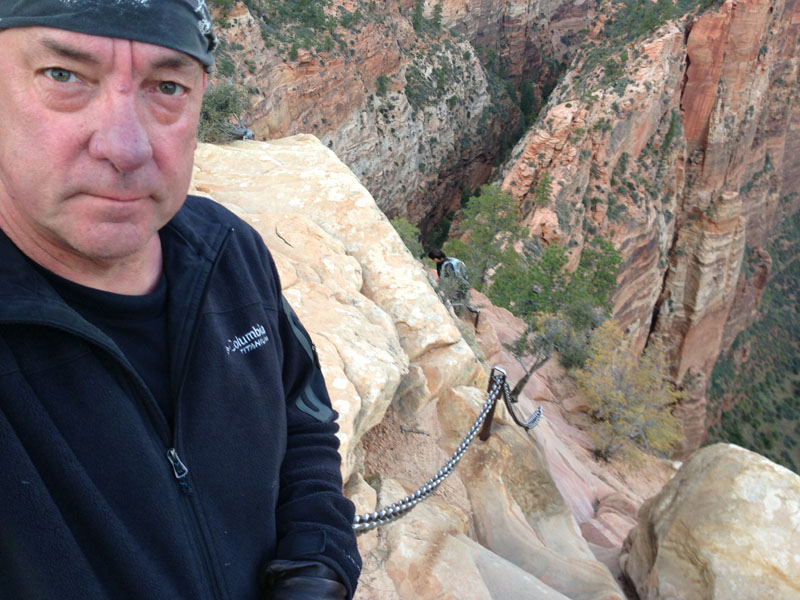 |
Not Looking Down |
Its author has mixed feelings about that. It is nice to be considered helpful to others on a road I had to travel, but...that's one road I could have lived without.
The setting of this story's opening photograph, Angels Landing, is a vertiginous outcropping of rock at 5,875 feet. It is reached by a narrow, perilous trail along a slender sandstone "fin," with drops of over a thousand feet on each side. The above photo shows the chains that are bolted into the rock in many sections, as much-needed handholds. Lose your step here and you will fall a long way. A sign at the trailhead offered a grim warning, "Since 2004, six people have died falling from the cliffs on this route."
That gives a cruel twist to Angels Landing.
On first looking over the map of hiking trails and their descriptions in Zion National Park, I recalled that all those years ago I had chosen the trail to Observation Point. Snapshot memories brought back images of climbing high up the canyon wall to the rim, over rounded contours of eroded pink, cream, and brown stone. Waves of rock were smoothed and symmetrically grooved by eons of moving water, where tumbling stones in flashfloods had engraved the sandstone. The all-important lunchstop at Observation Point had offered a stunning view down over the valley floor, where the bends of the Virgin River (a modest stream compared to the torrents that formed that canyon) shone through leafy cottonwoods, green with airbrush bursts of autumn yellow. Nearly always I choose a hike to a high vantage point, whether a summit or an overlook, to enjoy lunch with a view. (And to go downhill on the way back.)
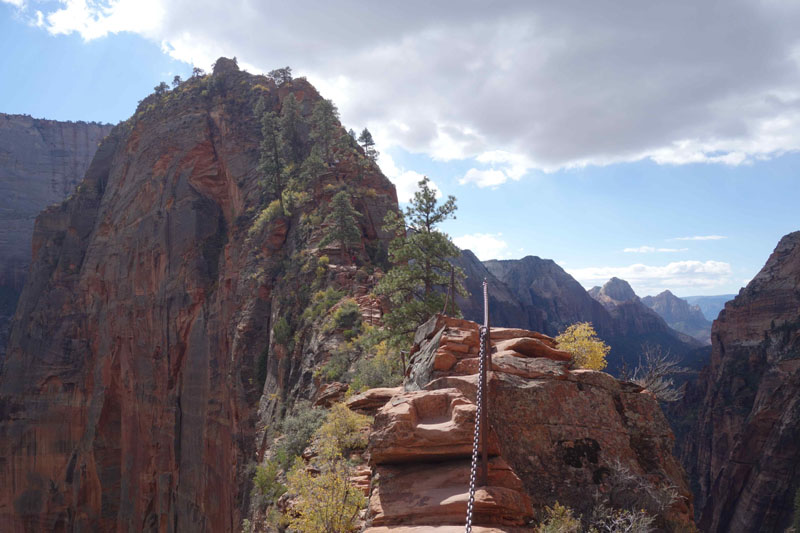
This time, my first notion was to repeat that same hike, and why not? But when I looked over the park's other offerings, I saw a trail called Angels Landing - too tempting, following on the recent end of our Clockwork Angels Tour, and an earlier story titled "The Better Angels." I like themes.
Here is a section of the trail, leading over a razor's edge of rock to the summit in the background, 1,400 feet straight down to the valley floor on both sides. Tiny steps have been cut into the sandstone (the trail has been maintained, and traveled, since the 1920s - apparent where the chains have worn grooves in the rock, like the action of stones in moving water). Those heavy chains on stanchions were very welcome, even indispensable. (I wouldn't have tried it without them.) Hauling myself upward with shoulders, arms, and legs made a full-body workout, and I was glad I had been back into my Y routine for a few weeks. (After the tour, I allowed myself a month or so of zero-exertion, but soon needed to be active again.) As I climbed, I did not look down, or to either side, just held on and watched where my feet and hands should go.
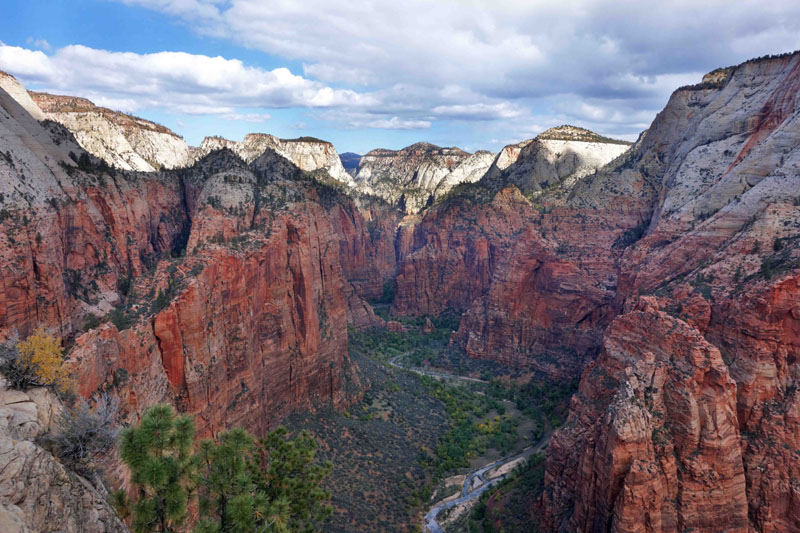 |
View From Angels Landing |
The trail was fairly crowded, and sometimes it was necessary to pause at a wider point and let other hikers make their way by. (Plenty of chances to do something nice for others that day.) If the experience became too "uncomfortable," I was mentally prepared to turn around and go back, as many people report doing. The cutoff before that last harrowing quarter-mile is called Scout Lookout, also nicknamed "Chicken-Out Point." Other hikers have reported feeling overwhelmed by fear, and one woman said she tackled the climb in the hope of conquering her fear of heights. She made it, but would never do it again.
Finally reaching the end viewpoint, a capstone peninsula like an "island in the sky," I found a space among the dozen or so other people to sit down for a few minutes. Rather than stopping for lunch and a rest as I usually would, I was keen to head down that trail - get back to "Chicken-Out Point" and put that dangerous section behind me. Lunch could wait.
From Scout Lookout down, the way was steep - including one set of something like twenty-one switchbacks called Walter's Wiggles (named after an early park superintendent who helped lay out the route). By noon, many more people were on their way up, though I noticed it wasn't a steady stream, but waves, with quiet periods between. I realized it was because of the trams. Since my visit fifteen years before, the main road through the park had been closed to private vehicles during busy times, and sightseers and hikers were ferried around the park on tandem buses they called trams. I had first encountered that solution to overcrowding and pollution at Denali National Park in Alaska in the late '90s, then soon after at Grand Canyon and Yosemite. The system was well organized for convenience and access, and that morning I had caught a smaller bus from my motel into the village of Springdale, where I bought my provisions for the hike. Crossing a footbridge into the park, I took the tram to the trailhead at the Grotto (a collapsed cave with waterfall).
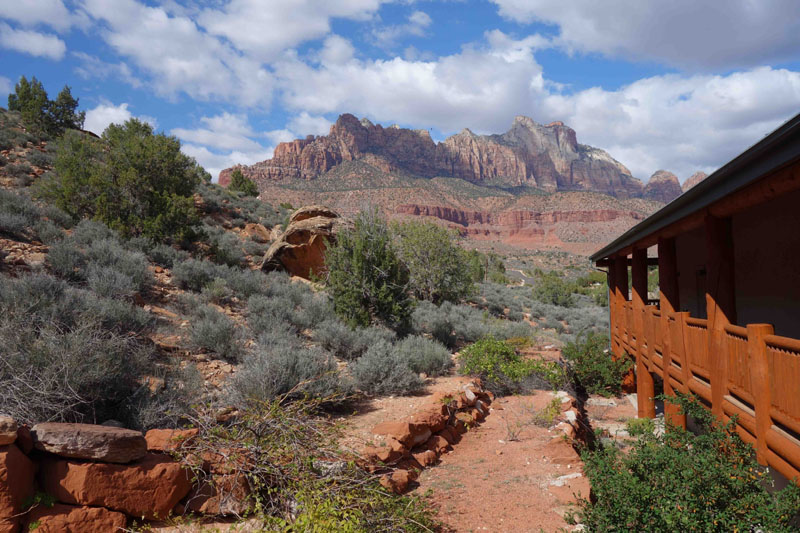
On the way down I had lunch there, then caught the two trams back to my motel. I felt weary and a little sore, but happy to have made it to Angels Landing (and back!). I was looking forward to a shower, a generous measure of The Macallan, and steak for dinner. As my friend Mendelson Joe says, "Every day is thanksgiving day."
Just before sunrise the next morning I drove up out of Zion Canyon on an incredibly "loopy" bit of road. Some long curving tunnels necessitated open windows and a gratuitous downshift to hear that wonderful V12 music. (The Aston Martin engineers deliberately designed "baffles" in the mufflers that open on startup, or above a certain RPM, to enhance the "auditory experience.") I paused often at overlooks to watch the light fading up on the immense cliffs behind me, the Towers of the Virgin and the Court of the Patriarchs. The canyon was too deep and narrow to admit the sun until much later in the morning, so it wasn't a "sunrise" so much as a "lightrise." The air was cold, but tasted fresh and clean, fragrant with pine, juniper, and sage.
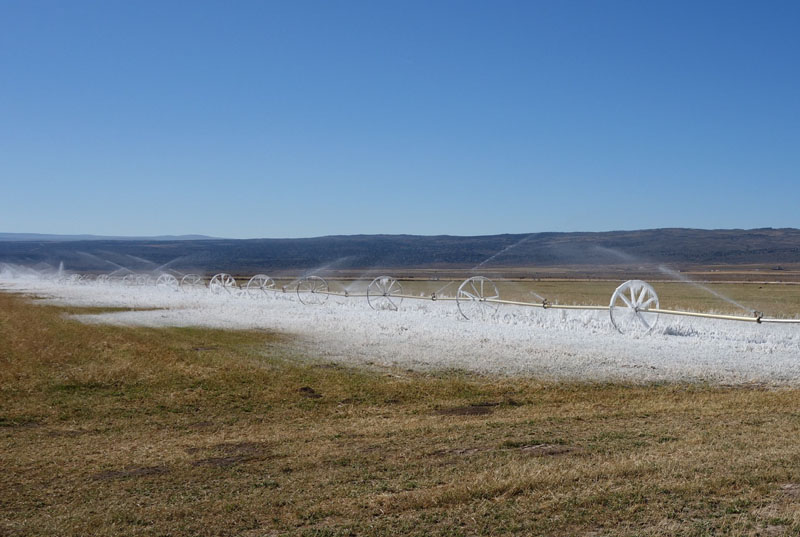
The road flattened out onto the plateau above the canyon, part of a vast geological upheaval called the Grand Staircase, rising strata of different eras of sedimentary rocks stretching from Zion Canyon through Bryce to Grand Canyon. (The National Park Service groups those three parks into what they call the Grand Circle, which makes sense now that I understand the geology.) Even on the plateau, the sun wasn't quite over the horizon yet, but the light was full over the open sage and juniper rangeland. The temperature was in the 20s, and under the center-pivot irrigation sprinklers blinding white frost had collected on the fields, making a surreal sight.
At that time of morning, I had been watching for deer, and saw a few, so kept my speed down. Ahead of me, two mule deer were standing on the right side of the road, feeding, and facing away from me. I slowed down even more, and blipped off a downshift to give a menacing roar - "Loud Downshifts Save Lives." As I came alongside the two deer, they started moving in the same direction as me, then suddenly - whoomp! - they dived right into me!
As I jammed on the brakes I heard the sound of a heavy body landing on carbon fiber (everybody knows that sound) as one of them fell on top of the hood, then slid to the ground. Shocked and disbelieving, I watched it lay there, hooves scrabbling against the pavement, for a horrible moment. My mind was racing in spirals, trying to process what was happening, and what I should do if it was hurt badly. (Unlike Michael in "Every Road Has Its Toll," where he had to put a wounded deer out of its misery with a bullet, I wasn't carrying.) I was mighty relieved to see it rise to its feet and hobble away to the other side of the road. It would surely be stiff and sore for a few days, and probably say some bad words, but I hoped it would be okay. I drove on, shaken, and shaking my head. Even Britain's millions of sheep aren't that dumb!
At such a slow speed, it was more like the deer ran into me than the other way around - so I didn't expect any damage. However, when I stopped later and looked, I saw a star-shaped crack, the size of a fist, right through the middle of the front bumper. The only way I can imagine a slow impact causing that kind of damage is a hoof. Probably on purpose - taking out its fear, and resulting anger, on the car.
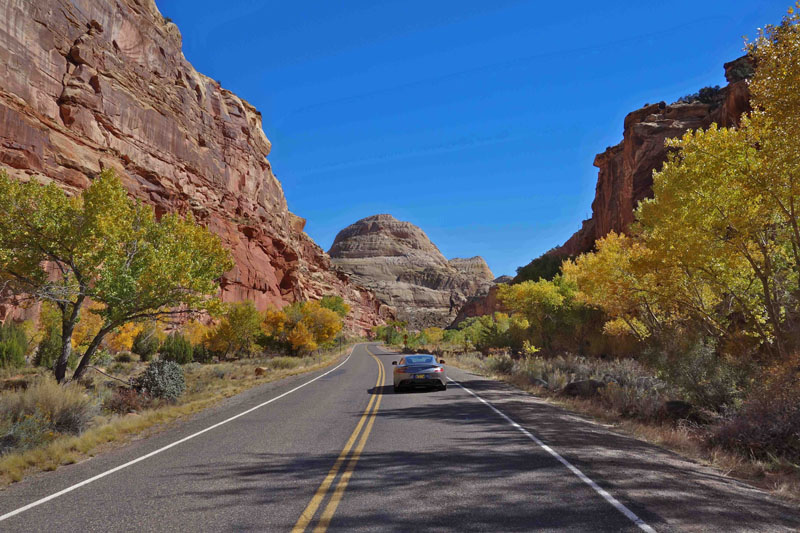 |
Capitol Reef National Park |
Because you would, wouldn't you?
I was not unduly bothered by the damage to the car, because no car that is driven through the great world, however carefully, is ever going to be perfect. That reality was accepted long ago, and I would rather drive a car with a few cosmetic flaws than keep it showroom perfect - especially on a drive like this one. I would get it fixed...sometime.
Which brings me to a choice I had to make about displaying the car in this story. I always avoid showing, or writing much about, the material possessions I have been fortunate enough to acquire. Part of that is native Canadian modesty - not wanting to seem to brag - but part of it is the wish not to arouse envy. It is a sadly common human trait to resent fine things others have, or begrudge their success or attractiveness. Envy is said to be motivated by primal instincts of competitiveness, and if schadenfreude is feeling pleasure from another's pain, plain old envy is feeling pain from another's pleasure. I have felt those poisons myself, as a youth, convincing myself I disliked someone when it was really envy, and it is an ugly emotion to have or receive. Having grown out of such bad instincts to the point where I envy no one (okay, maybe Jay Leno's Garage!), I equally have no wish to be disliked, even by strangers, for such negative reasons.
However, the car was as much a part of this story as my motorcycle is in others. So, despite the many gorgeous photos I captured of the car ("autoporn") against the stunning rock formations and autumn colors, I decided I would just show it from the back, as part of the scenery.
A quote from T. S. Eliot resonates with me.
"For us, there is only the trying. The rest is not our business."
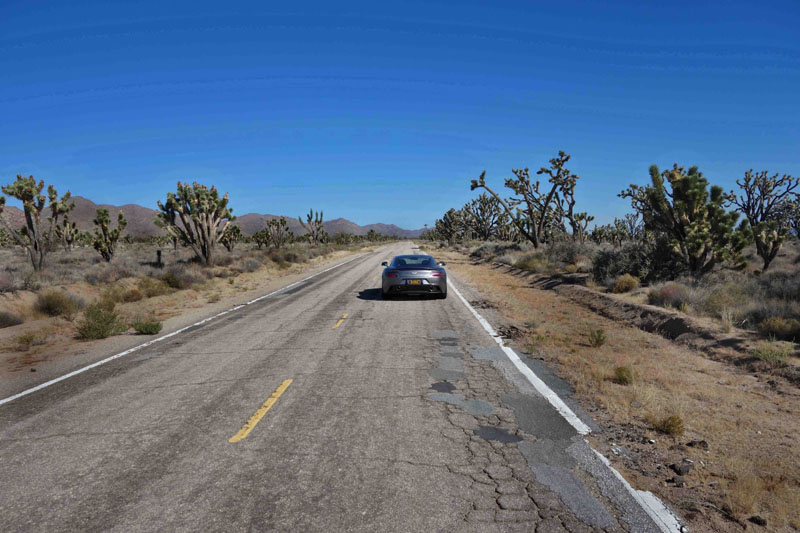 |
Joshua Forest, Mojave Desert |
That includes envy, politics, sociopaths, haters, Dilligafs, and suicidal deer...
On the first morning of this long-awaited road trip, I rose eagerly in the pre-dawn darkness. I aimed to get across the forty-mile width of Los Angeles before its usual weekday gridlock. My exit was smooth and swift, and by sunrise I was cruising into my beloved high desert, the Mojave. My route from there was undecided, for I had all day to reach Zion National Park, roughly 500 miles whichever route I chose, and I wanted to "improvise" a little. At Barstow I turned onto Interstate 40 instead of the direct route through Vegas on I-15. Following a whim, at Newberry Springs I turned off again, onto the "old road," the National Trails Highway, formerly the legendary Route 66.
John Steinbeck called it the "Mother Road" in The Grapes of Wrath, set in the 1930s, and by the late '40s it was a place to "get your kicks."
If you should plan to motor west
Travel my way, take the highway that is best
Get your kicks on Route 66.
The song was written by Bobby Troup in 1946, with lyrics that were partly a travelogue of his own post-war journey west "from Chicago to L.A." (from Pennsylvania, in his case). It became an immediate hit for Nat King Cole that same year, and has since been recorded by countless artists, from the Rolling Stones to Depeche Mode. (Seriously.) In the early '60s a TV series called "Route 66" portrayed the adventures of two young men with the all-American names of Buz and Tod. They drove around the country in an all-American Corvette, having adventures and helping people. (A worthy approach to life, then and now.)
By the 1980s the Mother Road had been entirely replaced by Interstate 40, and was decommissioned in 1985. (The number was then given to an unromantic stretch of interstate in Maryland.) Only vestiges remain of Old 66 now, service roads here and there, though there is an arc through Arizona that is evocative, and a fairly long section across the Mojave, where I was driving, through brown desert and green creosote. The characterful motels and diners, like Roy's, are all but gone, ghosts of a time before faceless chains and styrofoam food.
The first thirty miles east to Ludlow were very rough, the pavement crumbling and lumpy, but from there on it was smooth and empty. It occurred to me that driving Route 66 today is probably much nicer than it was during its heyday, when every truck and car traveling between Chicago and L.A. would have filled its two lanes in a slow, creeping parade. Today it is a joyride - back then it was probably...not.
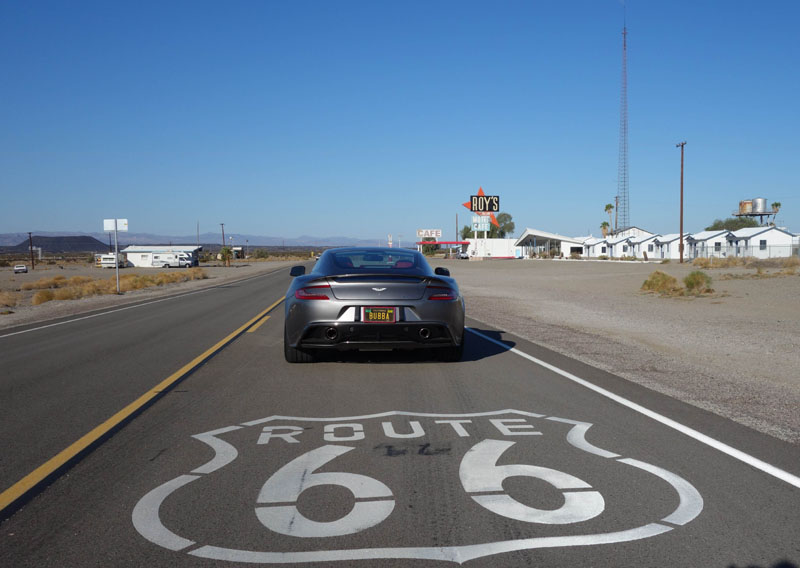
And dangerous? There were so many wrecks that it was sometimes called "Bloody 66."
As always, I paused at Roy's Motel for a photo, and I was determined to capture one of the big Route 66 signs painted on the road. (The only way to mark the route, because the actual metal signs are always stolen. Route 66 has been heavily fetishized, both by nostalgic Americans and romantic Europeans.)
I have written about Roy's Motel before, particularly in Ghost Rider. During the Test for Echo tour, in early 1997, Brutus and I stayed there one night. On a couple of previous stops for gas or lunch, we made friends with the owner, Walt. When we came to stay overnight, we brought wine to share with him and his mysterious chef, a Mexican-American who had cooked in some fancy places (if his stories were true) like Palm Springs and San Diego - but was now hiding in a burger joint in the desert. When I dropped by Roy's again in 1998, on the Ghost Rider journey, Walt told me he was hoping some soon-to-visit "money men" would invest in the place - build a swimming pool, even a golf course. That obviously didn't happen, and over the years when I have driven or motorcycled by (it's in the middle of some of my favorite Mojave routes), I saw the place continue to crumble. The cabins to the right, where we stayed, are no longer habitable - windowpanes broken, furniture gone. I sometimes wonder what became of Walt. Maybe still waiting for the money men...
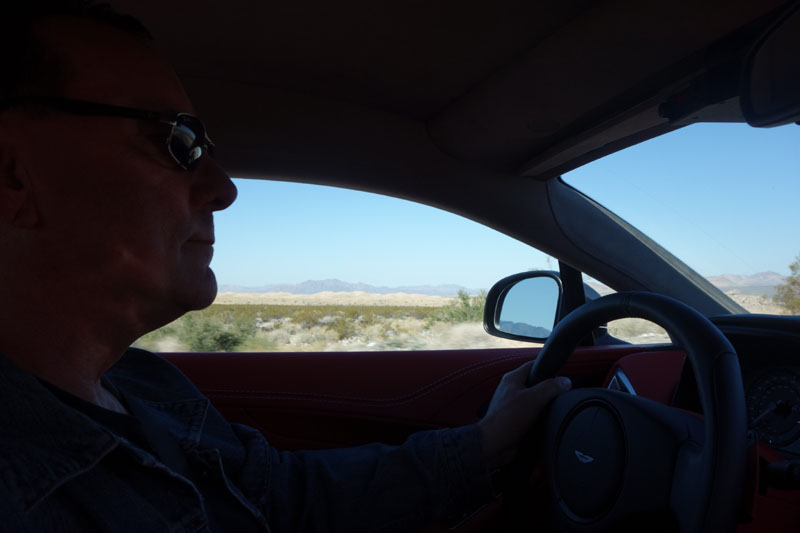 |
Passing Kelso Dunes |
Onward across the Mojave, up Kelbaker Road to the Kelso Depot (so many stories in these apparently "deserted" places). The patterned creosote rolled away gently for miles in every direction, to distant brown mountains. Northeast on the Cima Road, I turned onto a little-traveled strip of crumbling pavement through a fairy-tale land of wondrous Joshua trees.
This was a time to hook up the radar detector, to avoid any "surprises." On a straight, empty desert backroad it was safe and sensible to travel faster than the posted limit, and the odds of being ticketed were low. It would be a matter of bad luck there, while on the interstate, if they were trying to catch you, they would. That's why they call it a "trap." So I don't bother trying to speed there. As one of the band's professional drivers once said, "All a radar detector will tell you is when you are about to be pulled over."
Then it was back on I-15, the main route to Vegas. (I know now, but seem not to have known in the Ghost Rider years, that it is always just Vegas, never Las Vegas. Who decides these things? Like when San Francisco used to be "Frisco," but you can't call it that anymore.)
Driving through Vegas in the early morning, I decided it should be called "Ahhh, Vegas." A note of sadness for what it could have been, I guess. Its baroque immensity and spectacle were undeniably exciting to see from a distance, especially at night - but up close, not so much.
Regarding previous remarks about the U.S. government's current misdeeds, the arrogance and cold-hearted spite of a vocal few, I would not say that "Americans get the government they deserve." That's just mean. But it must be true that Americans get the entertainment they deserve. If they want to watch people humiliate themselves, or each other, that's what they're going to get - you cannot blame the "providers." Following the same reasoning, it must be true that Americans get the Vegas they deserve.
These days I am more tolerant of human...frailty than was "that other guy" fifteen years ago (hey - he had good reason to hate the world!), but I understand how Vegas offended his delicate sensibilities then. And the remark he made that people in the national parks were "half the size, with twice the vitality." That remains true.
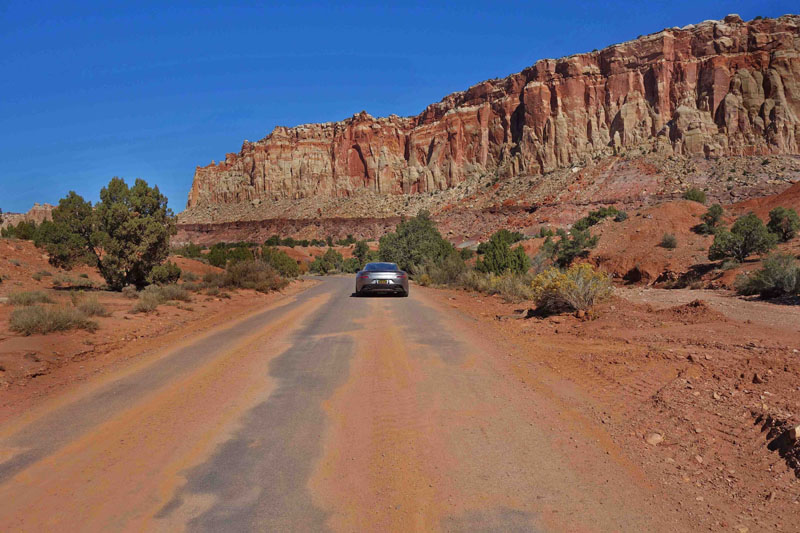 |
Capitol Reef National Park |
But as with all the world's complaints about humanity offered by the rest of humanity, what the hell are you going to do about it?
Shut up and drive, I guess.
Driving out of Zion that morning, I stopped for breakfast in Panguitch (just for the name!), then carried on north through irrigated hayfields and pastures. Several big magpies caught my eye, vivid in their black and white plumage, like flying pinwheels.
Once again I followed a whim, and turned off for Capitol Reef National Park. As ever, I was pleased to display my annual pass for the national parks - it felt like a membership card to an excellent club. After stopping at the visitor center for a passport stamp and some gifts for Olivia (always good kids' shopping in the national parks), I followed the scenic drive down through the park. It is centered around a geological uplift called the Waterpocket Fold (the name like something out of Tolkien). As in Zion, sedimentary rocks were eroded into colorful ramparts, domes (like the namesake Capitol appearing in a previous photo), arches, and branching canyons. The overall impression is "grandeur."
Backtracking a little to Torrey, I headed south on Utah 12, a winding delight of stunning views and little traffic. Some sections resembled a two-lane version of the trail to Angels Landing, a narrow, winding isthmus plunging away on both sides, seemingly at pavement's edge. As on that trail, I kept my eyes on the road. The day's ultimate destination was Bryce Canyon National Park, which was only about 100 miles from Zion - but I managed to stretch it to a very enjoyable 350 miles.
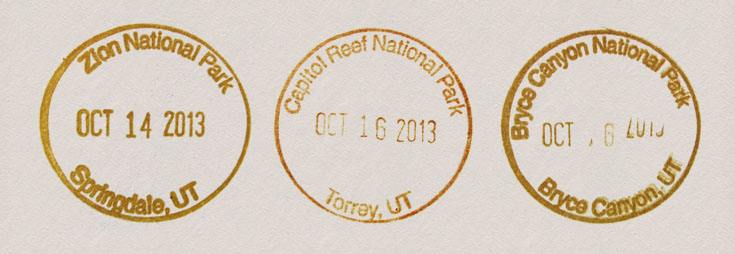
Stopping at the Bryce visitor center, I bought a few things and talked a little with the sweet lady behind the counter. In line with my "doing something nice for others" pledge, on my travels around Utah I was responding to those who seemed like they wanted to pass the time of day - a relaxed openness that my concert-tour schedule didn't always allow. I asked her if everybody around there was as happy as I was to have the parks open again, and she replied, " Well, I certainly am - but most of all for all of you, to be able to see these wonderful places."
I told her I had just driven down from Capitol Reef, and she said, "That highway 12 - I never get tired of that beauty."
I mentioned that my backup plan, if the national parks had remained shuttered, had been to visit Kodachrome Basin State Park, and she said, "I live between here and there, and that was a lot of people's backup plan. Including all the bus tours."
Oh yes, hadn't thought of that. Such bus tours were bringing many of the visitors to the area, foreigners and natives alike, on the "Grand Circle Tour" of Zion, Bryce, and Grand Canyon.
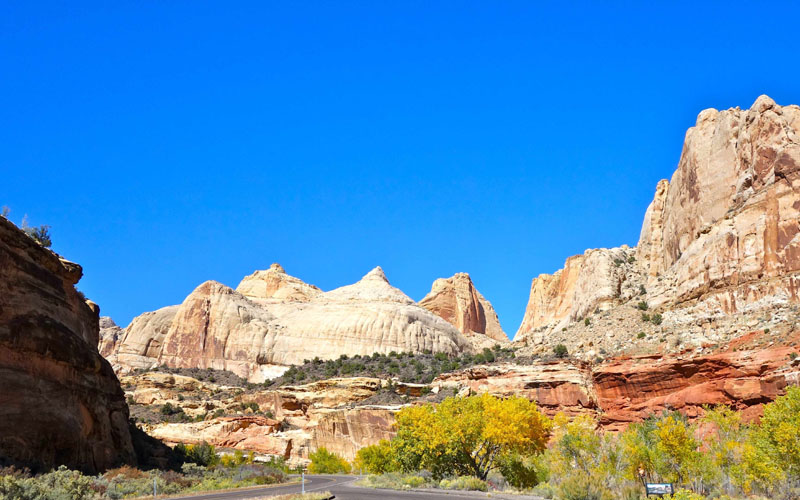 |
Capitol Reef |
Alas, I would encounter many of them that evening in the hotel dining room - where my heart sank to witness a crowded mass around the tables, and a lineup of about forty people at the door. However, Ruby's resort had been doing this for a long time (since the 1920s) and could handle it. The line moved quickly, the service was good (as my waitress reported, "We are used to it like this"), and the food was...good enough, under the circumstances.
However, the second night at Bryce I drove into nearby Tropic (just for the name - Tropic, Utah), and found a pleasant little restaurant. (Even served wine, which you can't always expect in Mormon Utah.) Both the menu and the small-town diner atmosphere suited me better than the resort experience.
My personal dining companions on that trip were my journal and a book, Weir's World, sent to me during the European tour by a Scottish fan. (Thanks Daniel!) It was a nicely-written, nature-based autobiography published in 1994 by Tom Weir (1914-2006), a Scottish mountaineer, birdlover, environmental activist, broadcaster, and sometime drummer. Later in life, he had been a popular television host, traveling around his country and "visiting" people, talking to them. (Another admirable way of life.) Weir's World recounted his background as a musician, climber, ornithologist, and explorer, both far and near - with occasional drams of whisky.
A man after my own heart. I enjoyed the book very much, and it suited my present surroundings and mindset perfectly.
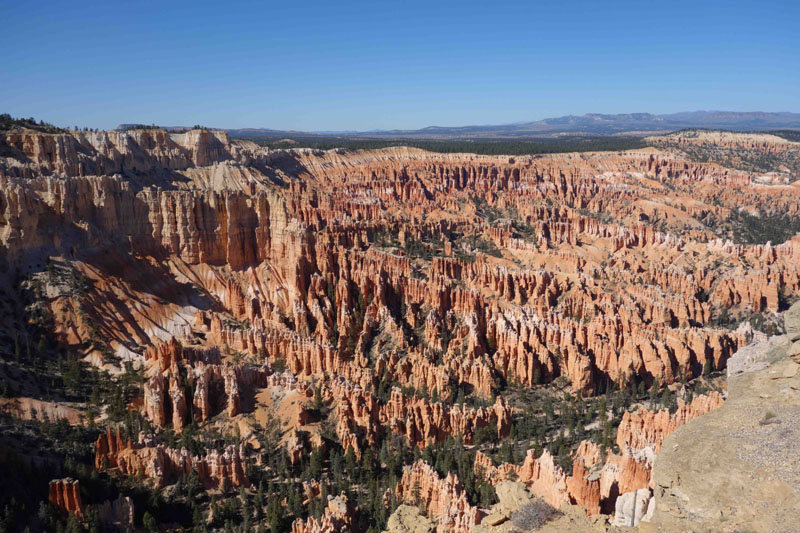 |
Bryce Amphitheater |
This is the view that etched itself on my memory fifteen years before, and sustained my impression that it was perhaps the most fantastic place I had ever seen. It is named for a pioneer rancher, Ebenezer Bryce, and the story goes that when he was asked what it was like to live around there, he said, "It's a hell of a place to lose a cow."
(Mormon sources change that to "heck.")
A glance at the trail map reminded me right away that the hike I did last time was called Fairyland Loop, and I remembered it as living up to that description. In the park newspaper it was listed under "Strenuous Hikes (steep grades with MULTIPLE elevation changes)," and described this way: "See the China Wall, Tower Bridge, and tall hoodoos on this spectacular, less-crowded trail."
They had me at "spectacular" and "less-crowded" - I would take it again.
(Hoodoos, incidentally, are the individual spires and pinnacles that make up that intricate landscape. It is from a similar root as "voodoo," and likewise has to do with "spell casting." Those hoodoos certainly are spellbinding. Paiute myths say the hoodoos were "Legend People," turned to stone by the trickster god Coyote.)
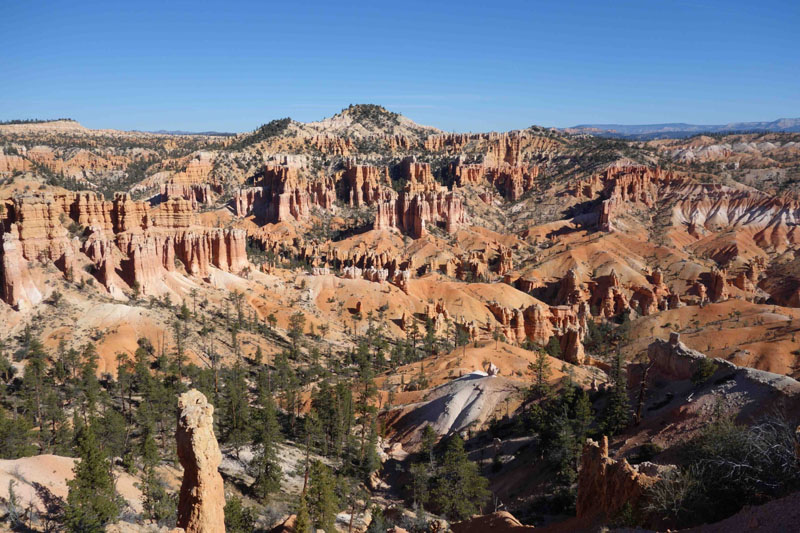 |
Fairyland Canyon |
(Love those tricksters - like Loki and Raven.)
The plateau above Bryce Canyon rises to over 9,000 feet, and the overnight temperatures were in the 20s. Sheltered walls of the higher overlooks showed a dusting of snow. Looking out in the early morning, I saw my car covered in sparkling white frost. So I took my time over breakfast and gathering my provisions for the day, seeing no reason not to let the morning warm up a little.
Wearing a windbreaker over a fleece jacket, gloves, scarf, and toque, I headed down from Fairyland Point. Almost immediately I stopped and took out my camera, pointing it in every direction. A smile spread across my face and stayed there for a long time. It seemed that every few minutes, around every bend in the trail, I was stopping to take more photos. As I had reported back in 1998, I took more pictures in Bryce Canyon than I had ever taken anywhere, and the same was true this time. It was impossible to get one image that was "emblematic," as might be done in most areas of natural splendor - Zion, Grand Canyon, Yosemite, Monument Valley, Yellowstone, even Death Valley from Dante's View. So many panoramas offered completely different impressions.
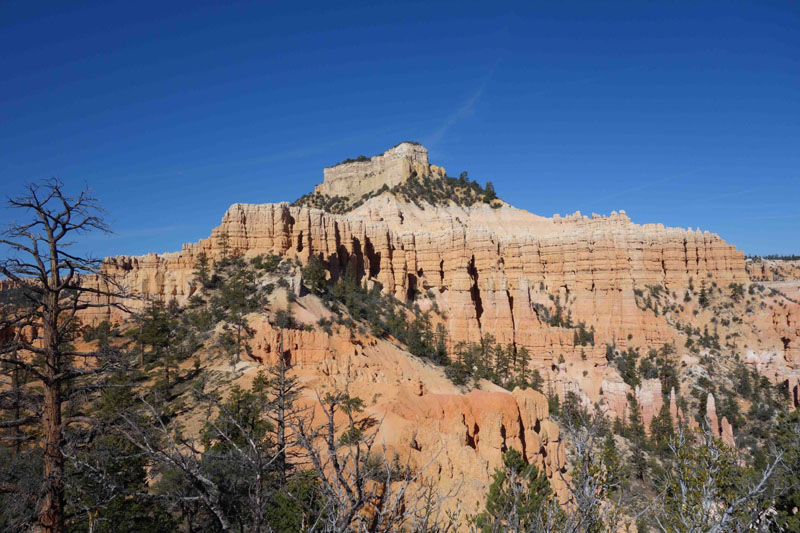 |
The Acropolis |
I don't know if that is the official name of this formation, but it's certainly what I thought of. (On the map it appears to be Boat Mesa). Other groups of hoodoos and eroded fins suggested pagodas, castles, melted ice-cream cakes, or sculpted bricks of wax. Around another corner would be a massive coral reef across from an array of gothic battlements, towers, and spires. Curving amphitheaters suggested a spectral choir, armored giants turned to stone (by a trickster), or the gigantic female figures that support the Parthenon - caryatids, I think. (Yes.)
A larger, or deeper, analogy occurred to me the first evening, outside my motel at Zion. I stood with my post-drive single-malt whisky and watched the evening light play on the mighty gray walls around me. The light seemed to penetrate the gigantic slabs of rock, or radiate from them. The power of that light seemed amplified by the sheer scale of those cliffs, and I sensed a kind of "hum." Or maybe something more like a steady "om," a vibrating chant of power and endurance. The words came to me: frozen music. Nothing mystical or psychedelic, just the notion that this was how frozen music would look, especially great symphonies and operas.
(Though I remembered a comparison I once made about Grand Canyon's visual impact being like "a power chord.")
Zion might be Beethoven, and perhaps Puccini, grand and impassioned, while Bryce might be Bach, an intricate monument. Somehow Capitol Reef suggested Mahler. I wrote in my journal, "Those rocks are not eternal, except compared to us - but they speak of eternity."
Sing of it, maybe.
Wonderful to reflect that it's all water music, too - all of those formations created by either moving water or ice. The fins and hoodoos of Bryce were gradually shaped by the cycle of frost and thaw in their crevices.
I learned something new from the recorded narration on the Zion park tram, too - that these massive slabs of sandstone had been formed not only by immense pressure from above (from ancient mountains and plateaus that had long eroded away), but also by a chemical reaction with minerals leaching through it, forming a kind of cement.
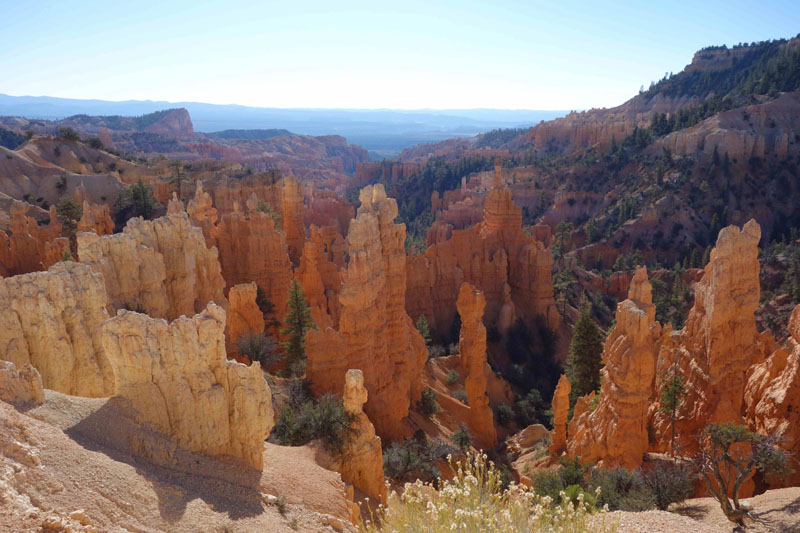 |
Fairyland Trailhead |
The Fairyland Trail was the opposite of my usual preference - descending at first, with several ups and downs ("MULTIPLE elevation changes"), then a steep climb to the rim trail. I prefer to attack the hard part of a hike first, when I'm fresh, then have a "homeward cruise" downhill at the end, when I'm tired. And have lunch at the top. But never mind. The scenery was clearly worth it, and could only be experienced that way.
Another factor at nearly 9,000 feet was the thinness of the air, apparently providing only seventy percent of the oxygen at sea level. I felt that on the uphill part, breathing deeply and steadily. (I noticed I used the same rhythm I do for long-distance swimming - three paces per breath.) I was glad to meet the Rim Trail, and know the climbing was over, but on the three-mile return on a more-or-less level section, my legs and feet seemed to ache more than they usually would. Perhaps the diminished oxygen affects recovery time, too. Surely it couldn't be my..."tender years"...
That phrase has a worthy connection with another recent adventure. Just a week or two prior to this journey, in early October, I drove up the Pacific Coast Highway to Drum Workshop. They had asked me to try out a new line of drums and see what I thought, and I was looking forward to doing some "aimless playing." For the first time in five years or so (see "Autumn Serenade"), I would sit behind the drums without serious intent, not rehearsing, recording, or performing, just playing.
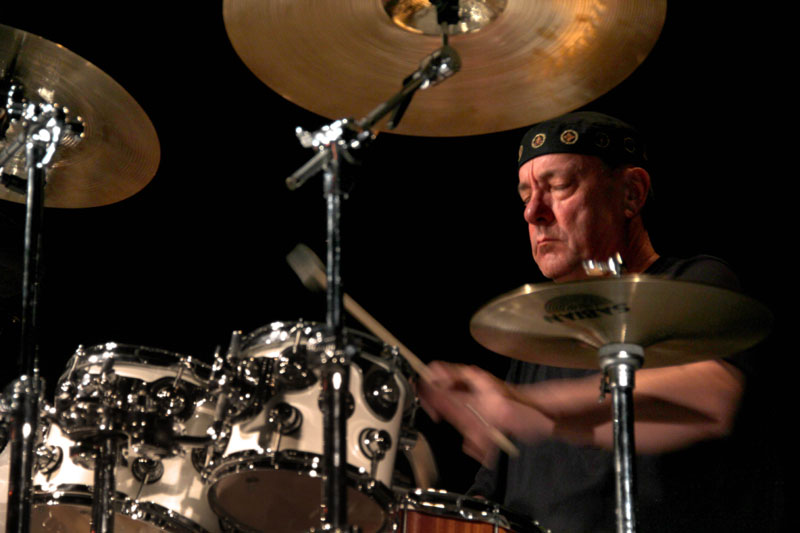
On my way there, as I drove into the farming country around Camarillo and Oxnard, I saw a number of fields groomed into brown blankets of bare earth - lying fallow to regenerate their nutrients. I smiled to think that during my own period of rest, my mind was allowed to be fallow - to refill the aquifer, and simply absorb energy to promote new growth. I was trying very hard not to have any ideas. Just a few minutes later, some idle train of thought led me across the phrase "tender years," and a spark lit up in my mind, "song title!" (Thinking with a dark smile, "You're not supposed to be doing that yet.")
"Tender years" refers to youth, typically, but I was struck by the larger application - because all our years are tender, aren't they?
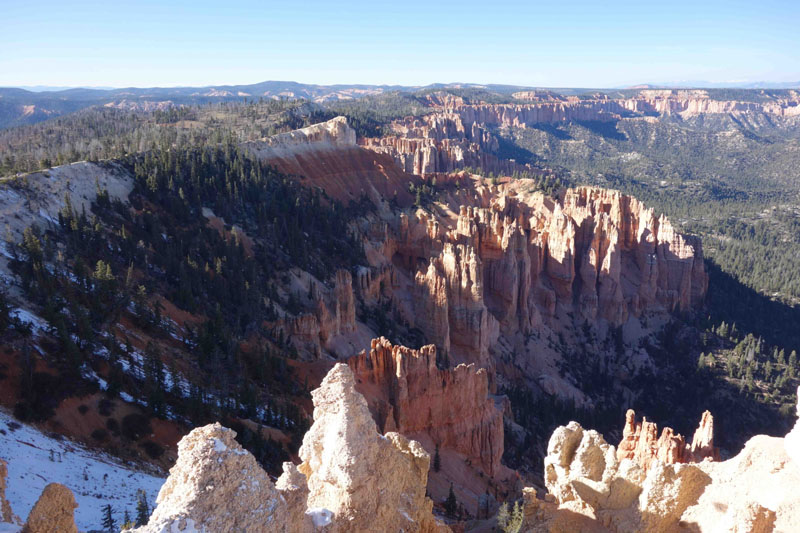 |
From the Rim |
From first to last.
Finally trudging my way back to Fairyland Point, I was relieved to climb into the car. I cruised easily (in both senses!) down the scenic road once more, thinking I would visit a few viewpoints I hadn't stopped at the previous day. Along with a few other vehicles, I paused to watch a herd of pronghorns feeding at the roadside. Sometimes wrongly called antelopes, they did display that characteristic delicacy and grace, and I had never seen so many together. "Prongers" had been headed for extinction in the previous century, and in thirty years of traveling America's backroads by bicycle, motorcyle, and car, I had never seen more than two at a time, and that rarely. Now they were on the rebound, largely thanks to the national parks.
I was still looking for the one overlook I remembered so well from fifteen years ago. I had a hunch it might be the one named after Ebenezer Bryce, so I parked there and walked toward the edge - hobbling at first until my legs unstiffened again. Out on the fenced-in point, I looked out and...there it was.
I looked left toward Inspiration Point, and around the indelible scene of what in my mind's eye I had thought of as the Heavenly Choir. (More frozen music.)
Three boys aged ten to twelve or so, with the clean-cut "whiteness" and sturdy clothing of Mormon children (in Utah, after all), were fooling around on the edge. One of them was kneeling down with his smartphone, then on his elbows, pretending to take "artful" photographs. He directed his two buddies, or brothers, in increasingly bizarre poses, and they all giggled.
With a smile, I held out my camera to him and said, "Could I get you to take one of me, please? You seem to be the photographic expert around here."
The boy looked down modestly and said, "Aw, I was just foolin' around."
I was left smiling to myself and thinking, "No! Really?"
Kids don't always get grownup humor - I remember.
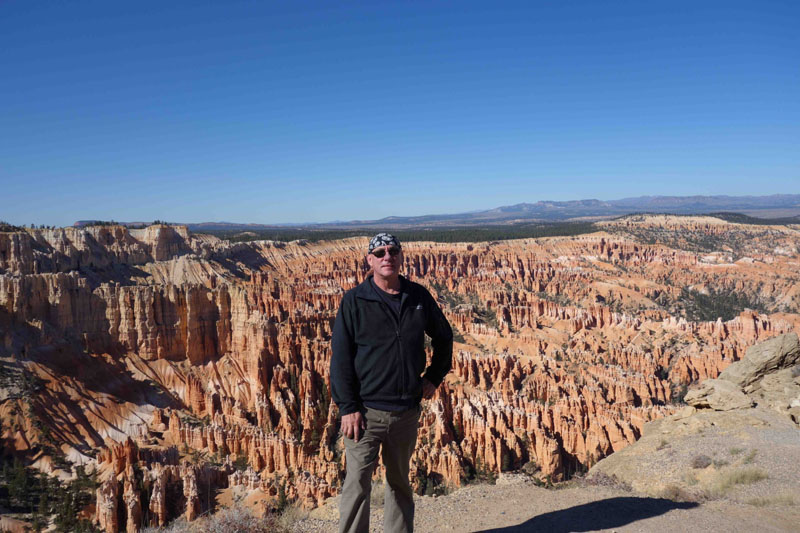 |
Bubba in Fairyland |
The boy took my camera and stood back, carefully composing the frame, then took a few shots. He still didn't seem satisfied, and continuing eyeing the composition, until I said, "Thank you, I'm sure that's got it."
I took back my camera, smiling again. Maybe someday that boy will see this and know that he helped me to capture the frozen music.
Early the following morning, at o'dark o'clock, the Ghost Driver loaded his luggage into the frost-covered car, and fired it up. (He had considerately parked away from the rows of motel rooms, knowing he would be leaving at an "antisocial hour." No DILLIGAF here.)
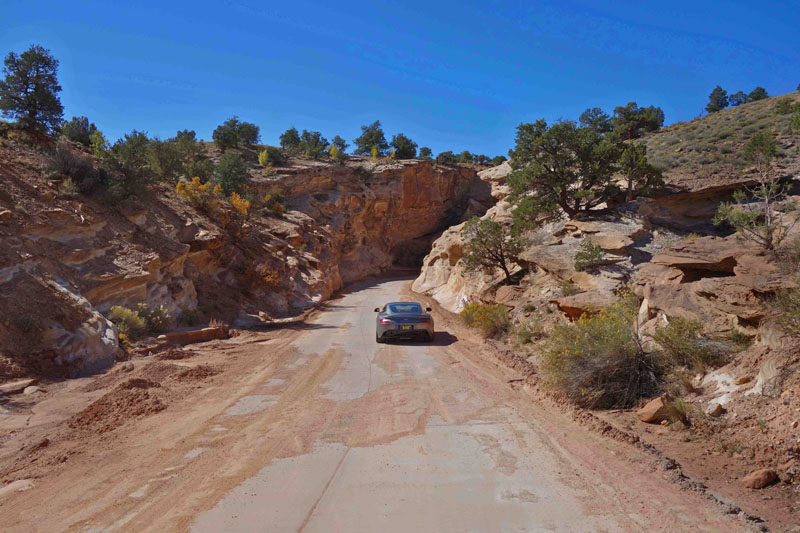 |
Bonus Picture |
Headlights on bright, he drove into the cold night, heading for home, feeling good, and watching for deer. Over the mountains on a dark, winding two-lane, then onto the interstate and breakfast at Denny's in St. George. Down through Vegas and across the wide Mojave, the Vanquish handled it all with alacrity and comfort. A ten-hour drive was no strain in that car, truly a Grand Tourer, and the 1,500 miles had been an absolute joy, as were the fifteen miles of hiking. Altogether, a memorable experience - one of his favorite road trips ever.
Now he was aiming for home, and the following night his wife and daughter would be returning from New York. He wanted to be waiting when they opened the door.
Angels Landing.